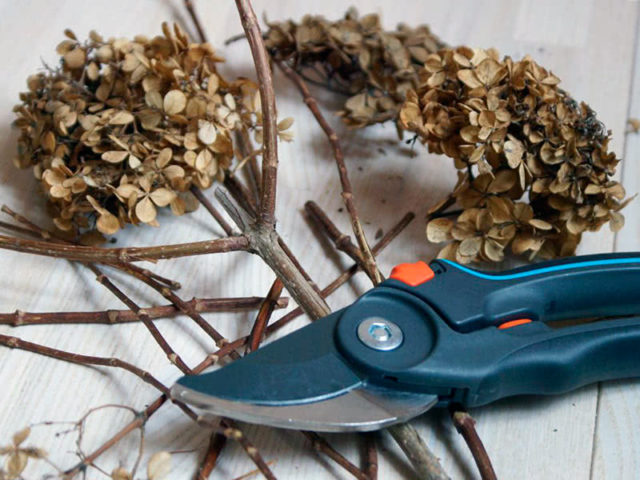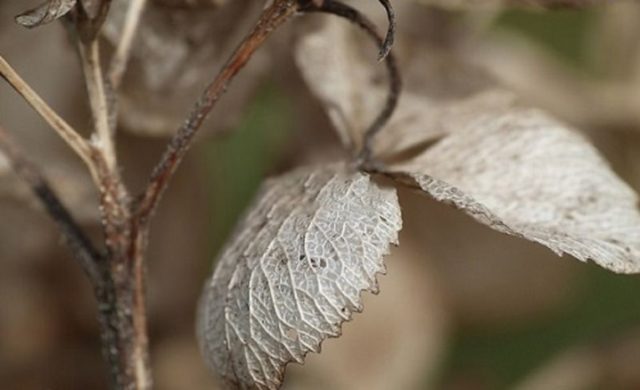Content
A perennial ornamental shrub, Hydrangea SchlossWackerbart, is distinguished by its unusually bright color of inflorescences. They are spherical, large, and are a real decoration of the garden. Another advantage of this culture is its long flowering from mid-summer until the first frost.
Description of hydrangea Schloss Wackerbart
This is an ornamental, erect shrub whose shoots do not fall apart. They are green, herbaceous, woody only 2 years after planting, and become gray. Their length does not exceed 1 m 30 cm. The width of the Schloss Wackerbart hydrangea bush grows up to 1 m.

Inflorescences are spherical, large, up to 25 cm in diameter, formed at the ends of the shoots of the first year
They consist of small flowers (up to 5 cm in diameter) with pointed petals.
At the beginning of flowering, all the petals of the Wackerbart variety are light green in color. Later they become pink with a blue center, which is bordered by yellow, long stamens.There is a lime green spot in the center of each petal. At the final stage of budding, Wackerbarth hydrangea flowers become pale green with a red border around the edges.
The leaves are large, up to 15 cm in length, oblong, pointed at the tip. The edge is jagged, the central vein is clearly visible. Their color takes on all shades of green depending on the lighting.

Hydrangea fruits are formed in the form of a capsule containing a large number of small seeds
Hydrangea Schloss Wackerbart in landscape design
This decorative shrub is used to decorate flower beds, alleys, and garden paths. Hydrangeas are planted in groups of several varieties each.

This plant looks impressive in group compositions, surrounded by evergreen trees and shrubs.
Also, Schloss Wackerbart hydrangea is planted in greenhouses, singly, as in the photo below, or used as a living decorative hedge.
How does the Schloss Wackerbart hydrangea overwinter?
The Schlosswacker barth hydrangea variety requires shelter for the winter. This should be a structure in the form of a hut made of dry branches, thus also covering the roses. You can also hill up the bush and cover it with agrofibre. In this state, the Schloss Wackerbart hydrangea will tolerate fairly severe frosts down to -18 ᵒC.
In warm regions of the country, Schloss Wackerbart hydrangea is hilled to a height of 30 cm. In areas with little snow, frosty and windy winters, a layer of peat or sawdust is placed on the bushes.
Before wrapping a flower for the winter, prune it, remove only dried inflorescences and remove all leaves.
Planting and caring for large-leaved hydrangea Schloss Wackerbart
This plant is hardy, survives in different climatic conditions, and is practically not susceptible to disease. It should be planted in well-drained soil in sunlit areas.
Selection and preparation of a landing site
Hydrangea Schloss Wackerbart is a shade-tolerant plant, but for bright, abundant flowering, it is planted in open areas, avoiding the proximity of tall shrubs and trees.
The soil should be loose, nutritious, well fertilized, acidic. If the selected seat does not meet these indicators, it is prepared.
Algorithm of actions:
- Dig and loosen the soil at the planting site.
- It is good to moisten the soil and apply liquid fertilizers suitable for this particular crop.
- If necessary, acidify the soil by adding a small amount of vinegar or special fertilizer.
Landing rules
First, planting holes measuring 30x30 cm are dug. The distance between them should be at least 1 m.
A third of the pit is filled with a nutrient mixture: humus and peat in a 1:1 ratio. Top dressing is poured with settled or rainwater.
The root of the Schloss Wackerbart hydrangea is placed in the planting hole in the center, the root collar should remain on the surface. The rhizome shoots are covered with fluffy light soil and lightly trampled.

After planting, the plant is watered abundantly, the tree trunk circle is mulched with a thick layer of sawdust
You can replace them with peat. The mulch is left for the whole summer. Occasionally rake, giving space for the growth of new shoots.
Watering and fertilizing
Hydrangea Schloss Wackerbart is a moisture-loving plant that loves abundant and frequent watering, especially in dry summers.
You will have to moisten the root weekly; for this, use about 1 bucket of water for each bush. If the summer is dry, the amount of watering is increased; if the weather is regularly rainy, it is enough to moisten the soil once a month.
To prevent the appearance of rot on the roots and improve their respiration, loosen the soil. During the procedure, they deepen by 5-6 cm. During the summer season, it is enough to carry out up to 2-3 loosenings.
Fertilizer application promotes abundant flowering and brightly colored buds. The procedure is carried out 4 times, starting in spring.
Feeding schedule for Schloss Wackerbart hydrangea:
- In the spring, after the snow has melted, during the period of active growth of shoots, 30 g of potassium sulfate and 25 g of carbamide (urea) are added to the root.
- A week before the expected flowering period, during the formation of buds, a solution of 50 g of potassium sulfate and 70 g of phosphorus fertilizer is applied under the root.
- The last two feedings are carried out until mid-August. The process uses the previous composition of a mixture of potassium phosphate and superphosphate.
From the second half of August, fertilizers are not used, and the amount of watering is also reduced. This contributes to the laying of next year's buds.
Pruning large-leaved hydrangea Schloss Wackerbart
The bush is pruned in early spring and autumn, before sheltering. Remove fading and dried buds. Shoots that did not have ovaries are shortened by half.

In the spring, dry, old, missing stems are removed; in the fall, the branches on which the buds have faded are pruned to the first healthy bud
Preparing for winter
In the fall, before the onset of the first cold weather, they begin to prepare the Schloss Wackerbart hydrangea for winter.First, remove all the lower leaves, leaving only the apical ones. This will speed up the process of lignification of the shoots and enhance their protection from the cold.
In the southern regions, Schloss Wackerbart bushes mount high. Often this is enough for the flower to overwinter. But the first year Schloss Wackerbart hydrangea is still recommended to be insulated using one of the methods suggested below.
In the northern regions, the tree trunk is covered with spruce branches. The shoots are bent to the ground and secured with staples. Peat is poured into the center of the bush, and the top is covered with spruce. This entire structure is wrapped in roofing felt, then secured along the edges with bricks or boards.

Old woody plants are not tilted; they are completely wrapped in agrofibre and tied with rope
Wire frames are installed on top like a hut. Then the entire structure is covered with a thick layer of dry leaves.
Reproduction
Cuttings are an easy way to get a young Schloss Wackerbart plant. The best time for the procedure is before flowering begins. It is important to choose a time when the shoots have not yet become woody, but buds have already begun to form at their ends.
The upper part of the shoot is cut at an angle of 45°, leaving only a couple of leaves. If buds appear at the ends of the branches, they are removed. The resulting cuttings are soaked in a growth accelerator, diluting it according to the instructions.
After soaking, the lower cut of the cutting is treated with dry Kornevin.
For rooting, prepare the soil: sand and peat in a ratio of 1:2. The soil mixture is thoroughly mixed and watered.
Schloss Wackerbart hydrangea cuttings are deepened by 2-3 cm. A distance of at least 5 cm is maintained between plants.Then the cuttings are sprayed with a spray bottle and covered with film. The container with the plants is placed in a dark, warm place. In hot weather, water daily.
In a month, the hydrangea cuttings will take root. The signal for this will be the appearance of new, green leaves.
As soon as the cuttings take root, the covering film is removed.

Young Schloss Wackerbart hydrangeas are planted, each should have its own pot; a mixture of garden soil with peat and sand is used as soil
Grown hydrangeas are grown in partial shade and watered regularly 2-3 times a week. The flower is transferred to a permanent place in the spring. The seedlings are first hardened off by placing them in fresh air for an hour.
Large-leaved hydrangeas, such as Schloss Wackerbarth, are also propagated by shoots. The procedure can be carried out in spring or autumn. Only healthy, lignified shoots are taken for planting.
To do this, dig up the bush very carefully so as not to damage the rhizome. Then the coppice shoot is separated. The separated branches are transplanted to a neighboring bed. They are cared for in the same way as the mother plant.
Diseases and pests
Hydrangea Schloss Wackerbart is not susceptible to diseases and attacks from harmful insects. But if cared for poorly, the flower may suffer.
Diseases:
- chlorosis – occurs when there is an excess of lime in the soil;
- leaf burns – appear if the hydrangea is constantly in direct sunlight;
- wet black leaves appear when there is excess moisture;
- leaf curling occurs after the use of herbicides.
Fungal diseases may also appear: powdery mildew, white rot, gray rot, rust.

The fungus multiplies if hydrangea is grown in closed flower beds with high air humidity or next to diseased plants
If the Schloss Wackerbart hydrangea grows in the garden, it can be attacked by harmful insects. Some of them crawl from nearby plants.
For Schloss Wackerbart hydrangea, aphids, spider mites, garden slugs, and root-knot nematodes are dangerous. It is important to regularly inspect the leaves and shoots of the plant. At the first sign of the appearance of harmful insects, treat the bush with chemicals.
Conclusion
Hydrangea Schloss Wackerbarth is one of the most beautiful plants of its kind. Bright large buds will decorate any garden and flower garden. The culture is quite unpretentious and requires minimal care. Diseases and pests rarely attack ornamental shrubs.













